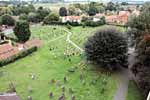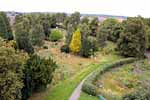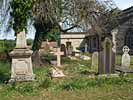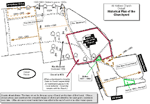For this church:    |
Ordsall All HallowsChurchyard
The churchyard is an irregular shape, but may orginally have been rectangular, and surrounds the church on all sides. The boundary is a mixture of hedges, fencing, metal railings and stone walling and in some places a mixture of more than one medium. The main entrance accessed from Church Lane consists of double metal gates on stone pillars with a stone wall on either side. The entrance leads on to an asphalt path and up to the south porch. The path splits with an access to the west tower and also provides a walkway through to one of four entrances on All Hallows Street. This entrance is open and leads straight on to the road via a concrete slope. The south-west boundary has wooden fencing at some points covered in hedging. It is adjacent to Ordsall House, one of several previous rectories. At least two previous rectors are buried close to the boundary, close to their former home. One such burial is that of Samuel Kelson Stothert who served as a Navy Chaplain in the Crimea. The western boundary separates the churchyard from the new vicarage. This was completed in 2010 and was built on the same site as the previous vicarage. A new wooden fence and gate complete this area. A path then leads to a wooden gate which allows access to the northern end of All Hallows Street. To the south-west, still on All Hallows Street, the churchyard is bordered by brick built cottages and a public walkway into the churchyard can be found at the side of one of the cottages. Completing the entrances is the stone surround and lych gate that was completed as part of the churchyard extension in 1955. It has double wooden gates set within a stone cover and surrounded by a low stone wall. Although the land was levelled at the time the access to the church is still at a gradient covered in part by paving stone steps.
The oldest burials are close to the church. The headstones and memorials are weather worn and some have totally collapsed. An extension to the churchyard was consecrated on 8th September 1874 by the Bishop Suffragan of Nottingham. The land had been a gift of Mrs Bridgeman Shipman. All those present knelt on the newly consecrated ground. The graveyard was further extended in 1905 and 1922. The land purchased in 1922 was paid for by subscription. The extension was an acre of land on the west side of the churchyard and in extension of it. The land was bought from Mr C.W. Kayser of Eaton Hall for £150. The vendor gave £50 towards the purchase. The Bishop consecrated half the land in December 1923. The other half of the land was to be used as recreation ground for the villagers until needed. Mr Kayser also offered another adjacent acre as a site for a new rectory. In 1951 an appeal was launched to raise money to purchase a one acre field to the south-east of the church. A triangular plot of land to the north of the church was also purchased, this portion being planted with flowers and vegetables. The resulting 'new' churchyard to the south was consecrated by The Bishop of Southwell (Dr. F Russell Barry) on the 19th July 1955. This brought the site to a total of three and a half acres. The total cost was £1250, but the lych gate and stone walling at the All Hallows Street boundary was paid for by a bequest for a family memorial under the terms of the will of the late Miss Sarah Ann North. The North family lived in cottages at the east end of the churchyard for many years and her father had worked as a blacksmith at the nearby forge. The architect was Mr T E Moon, who covered every aspect of the scheme on a voluntary basis.
This plan is taken from the parish web site, and is interactive there. The area marked 'allotment' has recently been set up as a Community Allotment having been neglected for many years. The area marked 'The New Churchyard' is now officially closed. Although full, 'The Old Churchyard' remains the responsibility of the Parish Council due to a decree signed by Queen Victoria tied into the granting of permission for the extension. |









